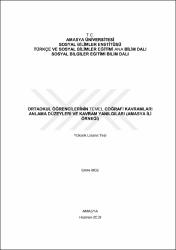Ortaokul öğrencilerinin temel coğrafi kavramları anlama düzeyleri ve kavram yanılgıları (Amasya ili örneği)
Özet
Bu araştırmanın amacı ortaokul 6., 7. ve 8. sınıf öğrencilerinin, sosyal bilgiler dersi coğrafya konularında geçen bazı temel kavramları (iklim, karasal iklim, akdeniz iklimi, karadeniz iklimi, muson iklimi, çöl iklimi, maki, bozkır-step, bakı, matematik konum, özel konum, paralel-enlem, meridyen-boylam, harita, ölçek, ova, plato, göl, deniz, okyanus, vadi, ada, kıta, heyelan, deprem, erozyon, çığ, nüfus, nüfus yoğunluğu) anlama düzeylerini ve bu kavramlara yönelik yanılgılarını tespit etmektir. Araştırmada nicel araştırma yöntemlerinden tarama modeli kullanılmıştır. Araştırma kapsamında belirlenen kavramların öğrenciler tarafından anlaşılma düzeylerini belirlemek için açık uçlu sorulardan oluşan bir test geliştirilmiştir. Geliştirilen test 2017-2018 eğitim öğretim yılında, Amasya ilindeki dördü merkez, üçü ilçe merkezi ve biri köy olmak üzere toplam sekiz okulda 6., 7. ve 8. sınıf düzeyinde öğrenim gören 585 öğrenciye uygulanmıştır. Elde edilen veriler anlama, sınırlı anlama, anlamama yanlış anlama ve cevap vermeme şeklinde kategorize edilerek incelenmiştir. Araştırma sonucunda belirlenen coğrafi kavramların öğrenciler tarafından yeterince anlaşılamadığı ve öğrencilerin bu kavramlarla ilgili çeşitli kavram yanılgılarına sahip oldukları tespit edilmiştir. Bunun yanında bazı kavramları anlama düzeylerinin alt sınıflarda yüksek, üst sınıflarda ise daha düşük olduğu belirlenmiştir. The aim of this study is to determine the 6th, 7th and 8th grade students' level of understanding some basic terms in social sciences course geography topics (climate, continental climate, mediterranean climate, black sea climate, monsoon climate, desert climate, maquis, steppe, exposure, mathematical location, private location, parallel- latitude, meridian-longitude, map, scale, lowland, plateau, lake, sea, ocean, valley, island, continent, landslip, erosion, snow slide, population, overpopulation) and their misconceptions regarding these terms. The scanning model being one of the quantitative research methods was used in the research. A test composed of open-ended questions was developed in order to determine students' level of understanding the concepts specified within the context of the research. The test developed was performed in the 2017-2018 academic year, on 585 students in the 6th, 7th and 8th grades at eight schools in total in Amasya province, four of which were in the city center, three were in the district and one in the village. The data obtained were examined by categorizing them as understanding, limited understanding, not understanding, misunderstanding and unanswered. As the result of the study, it was found that students did not adequately understand the determined geographical concepts and they had various misconceptions regarding these concepts. In addition, it was noted that some concepts' understanding levels were high in junior classes and lower in senior classes.
Bağlantı
https://tez.yok.gov.tr/UlusalTezMerkezi/TezGoster?key=FgmkGchPKo23qQqBeqzVZrpRctxJt_jwf-ecQoabCvgTuREnqb9YlqPl0_DO1XJihttps://hdl.handle.net/20.500.12450/1803
Koleksiyonlar
- Tez Koleksiyonu [318]


















